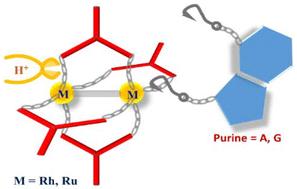当前位置:
X-MOL 学术
›
Dalton Trans.
›
论文详情
Our official English website, www.x-mol.net, welcomes your
feedback! (Note: you will need to create a separate account there.)
Detailed mechanism of a DNA/RNA nucleobase substituting bridging ligand in diruthenium(II,III) and dirhodium(II,II) tetraacetato paddlewheel complexes: protonation of the leaving acetate is crucial
Dalton Transactions ( IF 3.5 ) Pub Date : 2024-11-12 , DOI: 10.1039/d4dt02621g Iogann Tolbatov, Tiziano Marzo, Paolo Umari, Diego La Mendola, Alessandro Marrone
Dalton Transactions ( IF 3.5 ) Pub Date : 2024-11-12 , DOI: 10.1039/d4dt02621g Iogann Tolbatov, Tiziano Marzo, Paolo Umari, Diego La Mendola, Alessandro Marrone

|
Paddlewheel complexes of bimetallic scaffolds are emerging metallic agents in the bioinorganic chemistry landscape. In the most commonly employed construct, these complexes are decorated by the carboxylate moiety, prompting their possible deployment to target either protein or nucleic acid targets. In this study, density functional investigation was performed to assess viable mechanistic routes for the substitution of one acetate ligand with one chelating purine, i.e. adenine or guanine, in diruthenium and dirhodium tetraacetate paddlewheel complexes. This study evidenced the relevant stages of the process at an atomistic scale of resolution and provided for the encompassed rate-determining chemical events. Therefore, calculations indicated that acetate decomplexation as well as the concomitant nucleobase bridging proceeded gradually via a multistep process that included protonation of the leaving acetate. The present picture of the mechanism is envisioned to be relevant to the design and interpretation of experiments focused on the reaction of diruthenium and/or dirhodium tetracarboxylate complexes with nucleobases and eventuating in the formation of either nucleobase bridged-complexes or in the dismantling of the bimetallic construct.
中文翻译:

DNA/RNA 核碱基取代二钌 (II,III) 和二钌 (II,II) 四乙酰转轮复合物中桥接配体的详细机制:离开的乙酸盐的质子化至关重要
双金属支架的桨轮络合物是生物无机化学领域中新兴的金属试剂。在最常用的构建体中,这些复合物由羧酸盐部分修饰,促使它们可能部署到靶向蛋白质或核酸靶标。在这项研究中,进行了密度泛函研究,以评估在二钌和四乙酸二铵桨轮复合物中用一种螯合嘌呤(即腺嘌呤或鸟嘌呤)取代一种乙酸盐配体的可行机制途径。这项研究以原子级分辨率证明了该过程的相关阶段,并提供了所包含的速率决定化学事件。因此,计算表明乙酸盐的解络合以及伴随的核碱基桥接通过多步骤过程逐渐进行,其中包括离开的乙酸盐的质子化。目前的机制图片设想与实验的设计和解释有关,这些实验的重点是二钌和/或二铵四羧酸盐配合物与核碱基的反应,并最终形成核碱基桥接配合物或分解双金属结构。
更新日期:2024-11-12
中文翻译:

DNA/RNA 核碱基取代二钌 (II,III) 和二钌 (II,II) 四乙酰转轮复合物中桥接配体的详细机制:离开的乙酸盐的质子化至关重要
双金属支架的桨轮络合物是生物无机化学领域中新兴的金属试剂。在最常用的构建体中,这些复合物由羧酸盐部分修饰,促使它们可能部署到靶向蛋白质或核酸靶标。在这项研究中,进行了密度泛函研究,以评估在二钌和四乙酸二铵桨轮复合物中用一种螯合嘌呤(即腺嘌呤或鸟嘌呤)取代一种乙酸盐配体的可行机制途径。这项研究以原子级分辨率证明了该过程的相关阶段,并提供了所包含的速率决定化学事件。因此,计算表明乙酸盐的解络合以及伴随的核碱基桥接通过多步骤过程逐渐进行,其中包括离开的乙酸盐的质子化。目前的机制图片设想与实验的设计和解释有关,这些实验的重点是二钌和/或二铵四羧酸盐配合物与核碱基的反应,并最终形成核碱基桥接配合物或分解双金属结构。


















































 京公网安备 11010802027423号
京公网安备 11010802027423号